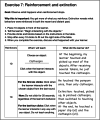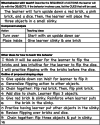The PORTL Laboratory
- PMID: 37425989
- PMCID: PMC10323058
- DOI: 10.1007/s40614-023-00369-y
The PORTL Laboratory
Abstract
In the history of the field, behavior analysts have used the operant chamber as an apparatus for both teaching and experimental investigations. In the early days of the field, students spent significant time in the animal laboratory, using operant chambers to conduct hands-on experiments. These experiences allowed students to see behavior change as an orderly process and drew many students toward careers in behavior analysis. Today, most students no longer have access to animal laboratories. However, the Portable Operant Research and Teaching Lab (PORTL) can fill this void. PORTL is a table-top game that creates a free-operant environment for studying the principles of behavior and their application. This article will describe how PORTL works and the parallels between PORTL and the operant chamber. Examples will illustrate how PORTL can be used to teach concepts such as differential reinforcement, extinction, shaping, and other basic principles. In addition to its use as a teaching tool, PORTL provides a convenient and inexpensive way for students to replicate research studies and even conduct their own research projects. As students use PORTL to identify and manipulate variables, they gain a deeper understanding for how behavior works.
Keywords: Laboratory experience; Operant chamber; PORTL; Research apparatus; Shaping; Teaching behavior analysis.
© Association for Behavior Analysis International 2023. Springer Nature or its licensor (e.g. a society or other partner) holds exclusive rights to this article under a publishing agreement with the author(s) or other rightsholder(s); author self-archiving of the accepted manuscript version of this article is solely governed by the terms of such publishing agreement and applicable law.
Conflict of interest statement
Conflict of InterestMary E. Hunter and Jesús Rosales-Ruiz are the authors of PORTL: The Portable Operant Research and Teaching Lab, the PORTL laboratory manual discussed in this article. In addition, the first author, Mary E. Hunter, is the owner of Behavior Explorer, the company that prints and sells the manual.
Figures





References
-
- Catania AC. Contemporary research in operant behavior. Scott; 1968.
-
- Catania AC. The course for which K&S was written. Revista Mexicana de Análisis de la Conducta. 2020;46(1):305–352. doi: 10.5514/rmac.v46.i1.76976. - DOI
-
- Elcoro M, Trundle M. Student preferences for live versus virtual rats in a learning course. International Journal for the Scholarship of Teaching & Learning. 2013;7(1):16. doi: 10.20429/ijsotl.2013.070116. - DOI
LinkOut - more resources
Full Text Sources
Research Materials
Miscellaneous
